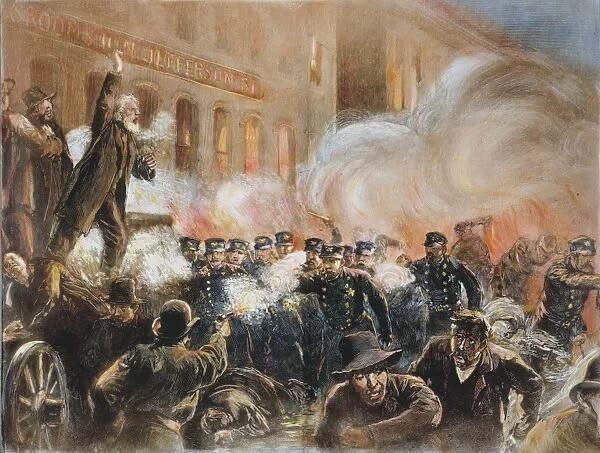Sunday Morning / September 1, 2024
It's Labor Day! An occasion not lost on Martin Luther King when he led the “March on Washington for Jobs and Freedom” just 61 years ago tomorrow. Whilst the Civil Rights Act of 1965 combined to lift Blacks out of poverty and into middle class 'Black jobs,' the Great Reshuffle went even further. Since 2021, over 130+ million people have quit their in-person jobs to repurpose themselves in more flexible work. According to the Pew Research Center, nearly half of all Americans now work in remote, hybrid or flexible schedules as traditional office work increasingly becomes a relic of the past.
A labor shortage in the United States and demand for flexible work is approaching a bellwether on par with the Haymarket Riots: a tipping point in 1886 when nearly 500,000 workers across the United States gathered to strike, protest, and riot for a 40-hour work week. The Central Labor Union and the Knights of Labor organized the first parade in New York City in 1887, and their protests culminated into a public holiday called Labor Day in 1894.
However, this strident symbol for the international struggle for workers’ rights is increasingly becoming passé. McKinsey and Company projects that by 2030 activities that account for up to 30 percent of hours currently worked across the US economy will be automated—a trend accelerated by generative AI.
Feeding prompts into a ubiquitous rut of permanent inequality, workers today are facing off with mercurial algorithms that increasingly contend with human perception, reasoning, learning, problem-solving and creativity. As the international workforce confronts the Fourth Industrial Revolution (4IR), an invasive algorithm is coming of age.
Industry 4.0
The First Industrial Revolution harnessed water and steam to mechanize production; 2IR used electricity to power mass production; 3IR engaged electronics + information technology to automate digital production; and 4IR prompted computers and algorithms to simulate the human experience.
The top industries in 2024 with the most exposure to AI were information, science, technology and finance, according to Pew Research. But the majority of remote jobs relying on AI went to computer and IT > marketing > finance > project management > human resources > and customer service.
Bland AI — the new conversational AI Platform — is eviscerating enterprise call practices with new automated phone agents. 'Blandy' is conversational; can handle one million phone calls simultaneously; and is expected to replace call centers with her warm and responsive discourse. She’ll even convince you she’s human.
Since the onset of the Industrial Revolutions, the history of work has been a recital of people outsourcing their physical labor to machines. Initially engaged to preform repetitive physical tasks, the Cotton Gin and Spinning Jenni were the first to replace animal labor. Today, machines are mimicking human intelligence to perform tasks that encroach on uniquely human traits like creativity, intuition, conscience, will and character.
Bezonomics
At Amazon, the world’s largest online retailer, machines are doing much the hiring, managing and firing with little or no human oversight. With 1.6 million employees worldwide, Amazon became the second largest private employer in part by outsourcing its sprawling operations to algorithms, sets of computer instructions designed to solve specific problems.
For years, the company has used algorithms to manage millions of third-party merchants on its online marketplace, producing complaints from retailers who allege being arbitrarily banned or falsely accused of violating Amazon’s standards and practices.
Recently, the company began ceding its HR operation to automation services to manage workers in its warehouses; surveil contract drivers; independent delivery companies; even the internal performance of its office workers and customer service operations. CEO Jeff Bezos says, "machines are reducing costs and giving Amazon a competitive advantage.”
Sixty-three year-old Army veteran Stephen Normandin joined Amazon’s gig-style Flex Team when it was created in 2015. Flex drivers handle packages that haven’t been loaded on an Amazon van before the driver leaves. Rather than making the customer wait, Flex drivers pick up the slack to ensure packages are delivered the same day.
But after nearly four years of racing around Phoenix delivering packages as a contract driver for Amazon, Normandin received a pink slip from a computer. “The automated system is insufficiently attuned to the real-world challenges drivers face every day,” says Normandin. “It seems the people who designed them don’t have any common sense about how the real world works.”
Former Amazon managers agree. “The company knew the machines would invariably lead to mistakes and damaging headlines, but decided it was cheaper to trust the algorithms than pay people to investigate mistaken firings so long as the drivers could be replaced easily.”
The use of algorithms to make decisions affecting real people’s lives is increasingly common. Today, algorithms approve loan applications; decide if or whether a prisoner should be paroled; and arbitrarily close credit card accounts, too. Even Chase, the largest commercial bank in the United States, has been accused of allowing algorithms to arbitrarily close primary checking accounts without a name, department, or even an explanation attached to the automated generated letter.

Wells Fargo and Company, San Francisco 1852
The AI revolution on Wall Street has arrived. Deutsche Bank uses AI to scan wealthy clients portfolios; J.P. Morgan Chase leads in AI research; Capital One in AI patents; and Wells Fargo in AI investments.
While the Algorithmic Fairness Act will attempt to legislate the receipt of information, it seems the nation's largest corporations are lawyering up. Littler Menelson, a labor and employment law firm in Washington DC, specializes in "developing and initiating strategies that lawfully avoid unions." Littler explains:
AI is increasingly being used by human resource and management teams, leading to increased scrutiny of how companies use the technology in hiring, termination and other employment contexts.
Perhaps why they poached Bradford Kelley? Kelley, who oversaw the Artificial Intelligence and Algorithmic Fairness Initiative at the EEOC, was trained to scrutinize AI and the American pie, i.e., federal civil rights laws.
The 2024 legislative session has seen a surge in state AI laws proposed across the United States. Consumer privacy laws enable both customers and employees to opt out of being profiled by AI. The Big Apple is blazing the trail.
All employers in NYC who use AI to hire must now disclose the same to their candidates, according to the new Automated Employment Decision Tool law. All corporations will also have to submit to annual independent audits to prove their system jives with the Civil Rights Act. Because bias is AI's fatal flaw. Open AI's CEO Sam Altman observes:
Like with all technological revolutions, I believe generative AI is a tool, not a creature, a tool that people have a great deal of control over.
A tool, in fact, that can displace human labor with an existential threat to humanity. As many as 300 million full-time jobs around the world will eventually be automated in some way by generative AI, according to Goldman Sachs. About 14 million positions will disappear in the next five years alone, according to the World Economic Forum.

Haymarket Riots, 1866
It was in essence the slogan of some 3000 workers at Chicago's McCormick Harvesting Machine Company in 1886 who triggered the nation’s first debate and federal law on labor.
They began peacefully under a light rain at Haymarket Square: "Eight hours for work, eight hours for rest, and eight hours for what you will,” before anarchists stormed the gathering with dynamite killing police officers and workers alike to ignite the first labor movement in the nation's history.
King invoked the slogan in '63 with a caveat. The right to work isn't just about jobs. It about labor understanding their civil rights, and how to choose for themselves between different possible courses of action unimpeded by powerful organizations in a progressive era.








